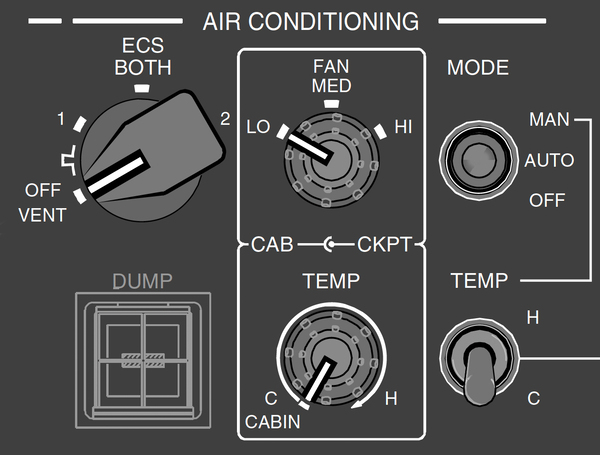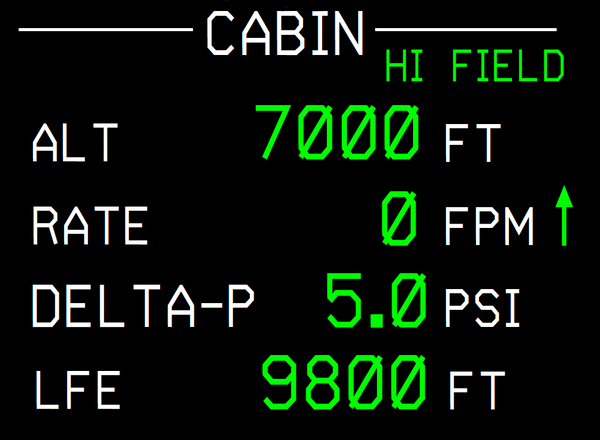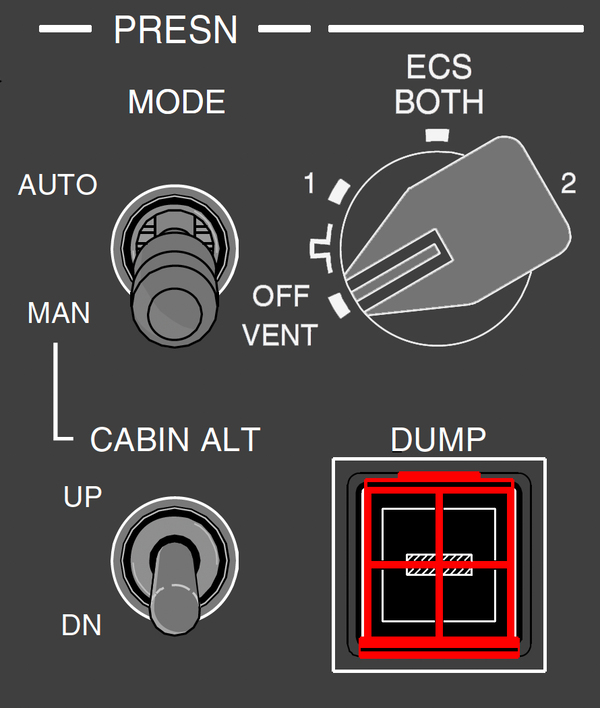Phenom 300 - Air Management
Cabin Fan Knob (Outer) - What is the true statement about the 'LO' position?

Aft Electronic Bay (E-Bay) Ventilation uses a temperature switch in order to monitor the temperature of the referred pressurized compartment, assuring it is under the acceptable value. The rear e-bay uses the exhaust air form OFV to provide ventilation for the equipment installed in this compartment.
Pressure Regulating Shutoff Valve (PRSOV) - When the OAT is above _____, both PRSOVs will be kept closed in order to avoid more hot air to be introduced to the cabin/cockpit.
The gasper air distribution system provides air to each pilot and passenger position. Air flowing from the Temperature Modulating Valve (TMV) manifold supplies the distribution ducts.
The temperature control system monitors the cockpit, cabin and air duct temperature to provide an automatic and independent zonal control for the cabin and cockpit areas according to pilot selection. The zone temperature is measured by temperature sensors (TS) located in the cabin area only.
The zone temperature is measured by temperature sensors (TS) located in the cockpit and cabin areas The system also includes duct temperatures switches (TSS) mounted in the inflow ducting.
The Pneumatic System consists of two independent similar engine bleed air circuits, one from each engine, which function is to provide temperature and pressure controlled pneumatic supply for the following user systems:
The Cabin Pressure Control System (CPCS) controls cabin pressurization and provides maximum safety and comfort during every segment of flight and ground operations. The CPCS operates in automatic and manual modes. Normal operation of CPCS is automatic.
Differential Pressure Indication - It displays the differential pressure between the cabin interior and the outside, in pounds per square inch, regardless of the operating mode. What is the true statement about the GREEN normal operating range?

Pressure Indication on MFD - The green color code is about normal operating range. It shows Cabin altitude below 8200 ft and below _____ for HI FIELD operations.

Automatic cabin pressure control is considered 'normal' airplane operation. The automatic control function is overridden by _____ whenever required.
Advertisement
The Negative Relief Valve (NRV) and the Positive Relief Valve (PRV) are _____ actuated valves and stay closed during normal operations. They will only open if the differential pressure limits are reached in order to prevent over and under pressurization of the fuselage, which may result in structural damage to the airplane.
The Electronic Control And Monitoring Unit (ECMU) has three independent channels: one controlling the cabin pressure automatically, a second one for manual control and the third one monitoring the cabin pressure and also providing a manual cabin pressure control through the PRESN panel.
The ECMU has two independent channels, one controlling the cabin pressure automatically and the other monitoring the cabin pressure and also providing a manual cabin pressure control through the PRESN panel. The manual channel has also a pressure altitude limit function to guarantee that both automatic and manual speed commands do not drive the cabin pressure to unsafe conditions. Each channel has one analog pressure sensor, to control and monitor/limiting the cabin altitude. The existence of two independent pressure sensors and two ways for cabin pressure control, besides data and electrical power supplies segregation gives the system compliance with all safety aspects.
Pressure Indication on MFD - It displays cabin altitudes in feet, regardless of the operating mode.
Only the LFE input is required from the pilots prior to departure. If the FMS is used, the LFE is automatically provided to CPCS. If not, the flight crew must input LFE through the GTC Airplane System page.
The fresh air supply system ventilation is activated whenever ambient temperature is over 30 deg.C (86 deg.F), during the ground operation. Both FCSOVs are automatically opened and fresh air is supplied by the condenser fan through the ram air line.
Both FCSOVs are automatically closed and fresh air is supplied by the condenser fan through the ram air line.
The "LANDING FIELD ELEVATION INDICATION" displays the destination field elevation in ft, regardless of the operating mode. What is the meaning of an information displayed CYAN?
Selecting the OFF VENT:

The Pressure Regulating Shutoff Valve (PRSOV) is automatically closed in case of a single engine takeoff or landing condition.
The Pressure Regulating Shutoff Valve (PRSOV) is automatically closed in case of a single engine takeoff (not during a single landing condition).
When pressed, the dump function is activated and a white striped bar illuminates on the button.

Air Conditioning Temperature Mode Switch - The AUTO mode selects the automatic operation of the temperature control system according to the pilot temperature zone preselection (cockpit only).
It selects the automatic operation of the temperature control system according to the pilot temperature zone preselection (cockpit and cabin).
Advertisement
When additional heating is required, the temperature control system automatically operates the Vapor Cycle Air Conditioning System (VCS).
When additional cooling is required, the temperature control system automatically operates the VCS. The VCS is composed of a vapor cycle machine with two refrigerant circuits, one for the cabin and the other for the cockpit, independently controlled and connected to a single compressor and condenser. Each refrigerant circuit contains an evaporator unit and includes pressure transducers to insure safe operation.
Cabin Rate of Change Indication - It displays the cabin rate of change in ft/min, regardless of the operating mode. The green color code is about normal operating range. Rates between:

In case of Cold Weather Operations or under external temperatures _____, the Environmental Control System (ECS) will optimize the cockpit temperature utilizing the high flow mode (AUX HEAT MODE).
Air Conditioning Temperature Mode Switch - What is the true statement about the 'OFF' position?

Cockpit Fan Knob (Inner) - What is the true statement about the 'HI' position?

What is the meaning of the 'EBAY OVHT' CAS (Caution) Message?
The air temperature is controlled through Temperature Modulating Valves (TMVs) which mix cooled air from the heat exchangers with hot bleed air from the engines (PRSOVs).
Both TMVs independently control the temperature of the bleed air released to the cabin and cockpit through the distribution ducts and gaspers. The TMVs may be automatically controlled by the system or manually by the pilot through the AIR CONDITIONING panel.
Cabin Rate of Change Indication – What is the meaning of an indication displayed in red color?
Manual regulation of the temperature is possible only with the AIR CONDITIONING MODE switch set to MAN position.
The Cabin Pressure Control System (CPCS) considers a takeoff or landing field above 9600 ft as a high field operation. In this case, the cabin altitude warning is reset to _____.
If the airplane altitude is above 25000 ft, even in takeoff or landing in a high field, the ECMU resets the system to operate in the original configuration, the EICAS message 'HI FIELD' disappears and the CABIN ALTITUDE HIGH alarm returns to 10000 ft cabin altitude.
Advertisement
Pressurization panel - What is the true statement about the DUMP button?

The Cabin Pressure Control System (CPCS) operational mode is automatically chosen according to the flight characteristics. The 'Flight Abort Mode' is activated in case:
If those requirements are met, the CPCS will set the Landing Field Elevation (LFE) back to the takeoff LFE, instead of the destination LFE. This will drive the CPCS to schedule the cabin pressure accordingly and prevent the system from pressurizing to a different LFE.
Air Conditioning Temperature Mode Switch - During operation in manual mode the independent zonal temperature control is not available.
The system operates for airplane ceiling up to 45000 ft, when at this altitude, the cabin altitude is approximately _____.
In normal operations the system has a CABIN ALTITUDE HIGH alarm which is activated at 10000 ft if the airport is below 8300 ft, the alarm is set to 11500 ft if the airport is above 8300 ft and below 9600 ft.
Flight plan on FMS must be closed to display landing field elevation.

